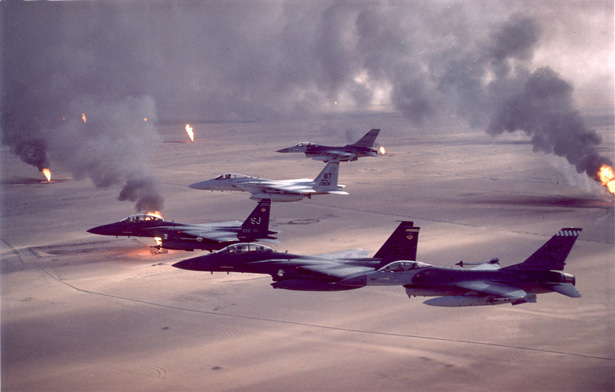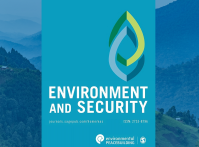-
Petro-Aggression: When Oil Causes War
April 25, 2013 By Maria Prebble
One year ago, the United States government froze all property of the Central Bank of Iran and other Iranian financial institutions within the United States. The move was part of a broader effort to compel the Islamic Republic to give up its alleged nuclear weapons program. How is it working out?
The evidence suggests that Iran’s economy is suffering considerably. But as with the sanctions against Iraq during the 1990s, there is less evidence that the economic pain is actually changing political behavior. Iran’s leadership remains defiant of international pressure. And just like the sanctions against Iraq, much of the economic hardship in Iran is borne by the poorest and most vulnerable members of society.
 The deeper question might be: How is it that the United States is in conflict with yet another major oil-producing state? Two out of the three members of George Bush’s “axis of evil,” Iraq and Iran, were oil-producing states. In the 1980s and 1990s, Libya was an American adversary and a keen supporter of a whole host of terrorist groups. Other oil-exporters, from Sudan to Venezuela, have also been a thorn in America’s side and destabilized international security. Is there something about oil wealth that makes states more prone to conflict?
The deeper question might be: How is it that the United States is in conflict with yet another major oil-producing state? Two out of the three members of George Bush’s “axis of evil,” Iraq and Iran, were oil-producing states. In the 1980s and 1990s, Libya was an American adversary and a keen supporter of a whole host of terrorist groups. Other oil-exporters, from Sudan to Venezuela, have also been a thorn in America’s side and destabilized international security. Is there something about oil wealth that makes states more prone to conflict?In my new book, Petro-Aggression: When Oil Causes War, I explore the relationship between oil-exporting “petrostates” – defined by having oil exports of at least 10 percent of GDP – and aggressive foreign policy. I argue that the effect of this oil income depends heavily on the domestic politics of the petrostate. In certain circumstances – namely, when a government is post-revolutionary or otherwise aggressive – oil makes interstate conflict more likely.
Oil income generates some incentives that increase the probability of aggression, and other incentives that decrease it. The net effect depends crucially on the preferences of the petrostate’s leadership.
Oil facilitates risk-taking by petrostate leaders. Oil income is easily controlled by the central government, which gives a leader an independent source of financial resources that can be used to buy political support. Consequently, a petrostate leader rarely faces domestic political accountability, and thus a low risk of being removed from office for risky actions. This fact underpins much of what is known as the “resource curse,” a collection of political and economic problems that range from authoritarianism to feeble economic growth to frequent civil wars.
In non-petrostates, one of the reasons that leaders tend to avoid international conflicts is because they know that if they lose, they are very likely to be removed from office, either peacefully or violently. In a petrostate, by contrast, a leader can buy off political opposition. He can afford to take risks, including those involved in aggressive foreign policy adventurism. That means a leader like Saddam Hussein can take his country into two very costly wars, lose, and still maintain his control on the presidency.
Of course, not all leaders have aggressive preferences. Saudi Arabia is the largest producer of oil in the world but has rarely been involved in direct interstate militarized conflict. As already mentioned, oil creates multiple incentives, some of which discourage international conflict. One example: any conflict that interrupted the flow of oil export sales would impose a significant financial and economic opportunity cost on the petrostate (although this did not stop post-revolutionary Iran and Iraq).
The combination of oil income and a revolutionary government poses a special threat to international peace. When a leader comes to power through a tumultuous domestic revolution – like Hussein, Qadhafi, Khomenei, or the current supreme leader of Iran, Ali Khamenei – he is much more likely to have aggressive, risk-tolerant, ambitious preferences. Oil income amplifies the opportunities for such a leader, meaning that in petro-revolutionary states, the overall effect is to make aggressive foreign policy more likely. In non-revolutionary states, the incentives generated by oil tend to cancel each other out. So oil and revolutionary leaders are a deadly combination.
Stacy VanDeveer: Will using less oil affect petrostate stability? Libya under Qadhafi illustrates this tendency. At the height of Libya’s revolutionary period, from 1969 to 1991, Qadhafi engaged in a multitude of international conflicts and violent struggles. He fought a series of overlapping and violent conflicts with Chad. He clashed militarily with Egypt and the United States, and deployed troops against Tanzania in Uganda. He supported a wide range of foreign insurgencies and rebel groups, from Abu Nidal to the Irish Republican Army and the Black Panthers, and sustained a nuclear weapons program for more than three decades before reversing course in 2003 as part of his reconciliation with the West. Perhaps most famously, Qadhafi sponsored several acts of international terrorism in the 1980s, including the Lockerbie airline bombing. Few countries of Libya’s small size have a history of such intensely violent foreign policy. Qadhafi’s personal characteristics and his control of Libya’s oil wealth contributed much to that violence.
So, given Iran’s oil wealth, is there any good news here? One silver lining is that the research shows that this toxic combination of oil income and revolutionary government tends to disappear once the individuals that led the original revolution leave office. Ali Khamenei is one of the original 1979 revolutionaries, and no longer a young man (born in 1939). If the United States and its allies can be patient, there is likely to be a significant opening for a rapprochement with Iran once Khamenei dies or leaves office.
Jeff Colgan is a Wilson Center fellow and assistant professor at the American University School of International Service with a special focus on global oil politics. Petro-Aggression: When Oil Causes War is available from Cambridge University Press and will be launched at the Wilson Center on March 27.
Photo Credit: U.S. Air Force F-16A, F-15C, and F-15E fighter aircraft over burning oil fields in Kuwait, courtesy of the U.S. Air Force. Video Credit: CCTV and Sean Peoples/Wilson Center.
 A Publication of the Stimson Center.
A Publication of the Stimson Center.







